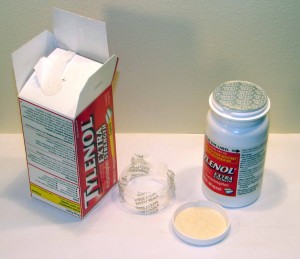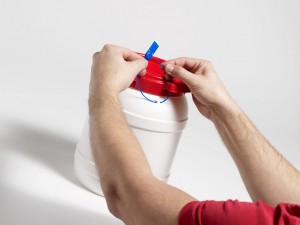By CurTec International
Tamper-proof packaging
Overview
Maintaining product integrity is becoming ever more important for life science companies as medicines and ingredients become more complex and sensitivity; as reputational risks mount and as the regulatory environment becomes increasingly complex and demanding.
The industry also faces mounting threats from criminal damage, theft and counterfeiting.
The net effect of these various factors has been to highlight the importance of tamper-proof and tamper-evident packaging, shifting the focus up the pipeline from goods on the shelf to those in transport and storage.
CurTec International is well aware of the high stakes involved, building tamper proofing into every aspect of its secure packaging solutions.
Background
A compromised pharmaceutical product or API (active pharmaceutical ingredient) can cause serious loss to manufacturers and suppliers. More
important, it can result in serious injury or death. One of the most shocking instances was the 1982 Tylenol Crisis in the USA when seven people in Chicago died after taking painkiller capsules that had been deliberately adulterated with cyanide after the product reached the shelves. More often, injury or fatalities can result from criminal counterfeiting, as with importation of fake Gentamicin into the US during the 1990s or counterfeit diabetes medication in China in early 2009.
The World Health Organization (WHO) estimates that up to 10 per cent of medications currently sold worldwide are counterfeits. This is underlined by the European Consumers’ Organisation report that over the past five years there has been a more than 400 per cent increase in the quantity of counterfeit medicines seized at EU borders.
Modern medicines and APIs are also more sensitive to breaches caused by accident or careless handling that can expose them to airborne or moisture contamination.
In parallel with the increased threat, current regulatory regimes place increased emphasis on proof of continuous integrity during transport in ensuring regulatory approval and quality control.
The security of finished dosage forms, such as tablets and capsules in blister packs and tamper evident containers, has become established in the pharma industry. Measures introduced include:
- Radio Frequency Identification (RFID) for commonly counterfeited drugs such as Viagra, OxyContin, and the AIDS drug Trizivir. All prescription drug packaging in the USA must now incorporate RFID to meet FDA standards
- DNA codes for anticancer drugs such as those introduced by Bristol Myers Squibb in 2003
- Nano scale trace detection materials introduced into the drug substance
- Addition of cryptographic files to the final artwork of the packaging or special packaging inks which are detectable only under specific wavelengths
However, the risk of contamination is present throughout the whole supply chain, placing new emphasis on making larger containers tamper-proof and tamper evident.
Principles
Technology and innovation can offer several levels of security for bulk containers of APIs and product during transport and storage, which include nestable polymer crates, bulk drums and containers with screw on or snap on lids to. The choice of container depends on the format of the material being transported, the quantity, the capacity of the container and the required level of protection and cleanliness or purity.
Essentially, securing containers against malicious action is like securing a home against burglars. One cannot hope to defeat the ingenious and experienced criminal forever, but one can make his task so difficult and time-consuming that he will go in search of softer targets.
The two main principles that apply to designing tamper-proof protection are that:
- No single level can be regarded as 100 per cent secure and therefore ultimate tamper-proofing requires multiple layers of protection and
- The protection has also fulfilled its role when it is tamper evident, revealing when container integrity has been compromised.
Four main levels of security can be applied to transport and storage containers.
- Level 1: Primary closure: securing the lid of the container so that it cannot be accidentally loosened, nor purposely removed and replaced without this fact being recognized.
- Level 2: Inner seal: this may take the form of an inner liner, foil or polymer film adhered to the container rim under the lid, that performs the dual purpose of providing extra protection against air and moisture contamination while also forming a tamper evident seal.
- Level 3: Shrink-wrap: Heating equipment can be used to apply polyolefin, polyethylene, PVC or other shrink-wrapping or shrink bands around removable lids. In all cases, this must be torn or cut to gain access to the primary closure and is difficult to reapply without professional equipment.
- Level 4: identification: unique and verifiable identification marking guards against container substitution or replication. This allows scanning at each end of the supply chain to compare inventory with manifest and actual stock to check that quantities and identity of containers tally. This is extremely important in Good Manufacturing Practice (GMP) for pharmaceutical companies as the purity and provenance of all material components needs to be documented prior to incorporation into the manufacturing process.
The choice of which and how many of these layers to apply will depend on the value and sensitivity of container contents, regulatory regime and also the application being supplied.
CurTec Tamper-proof solutions
All CurTec plastic packaging is designed to accept tamper-evident seals.
- Drums, nestable drums and ClickPack containers are fitted with pre-drilled holes and lugs that accept sealing pins or pull tight sealing tags that cannot be refitted once removed.
- Sealing pins and tags provide a more cost effective and user-friendly solution than shrink wrap or safe seal label, which can also be fitted to CurTec drum and jar-type containers.
- With Packo containers, the tamper evident tear off strip is an integral part of the lid design.
- All lidded crates can be fitted with tamper evident sealing strips or sealing pins that must be removed to open the crate.
- Unique ID codes, barcodes or RFID tags can be attached direct to the container for track and trace systems.
No matter which tamper evident solution you choose, it will increase the safety of your valuable goods, reduce cost caused by product damage and increase your customer’s satisfaction.
CurTec can also provide custom packaging and design an ideal packaging solution for customer requirements. This normally entails performing a Packaging Scan of their (packaging) supply chain. This will provide a full and detailed review of any specific packaging requirement, supporting the customer to reach the most suitable and cost-effective solution.
Each Packaging Scan multi disciplinary session covers:
- Optimal protection of product
- Product image and communication
- Quality and legislation
- The total packaging chain/ storage and shipping/logistics
- Handling issues
- Environmental aspects
- Hidden costs and added value

Tylenol

RFID Tag

Protection against moisture, tampering and contamination
Resources
Click on Tamper-proof packagingfor downloadable White Paper.
Click on CurTec to contact the company directly
Supplier Information
Supplier: CurTec International
Address: Spoorlaan Noord 92, P.O. Box 25, 5120 AA Rijen, Netherlands
Tel: +31 88 808 2000
Fax: +31 88 808 2260
Website: www.curtec.com















